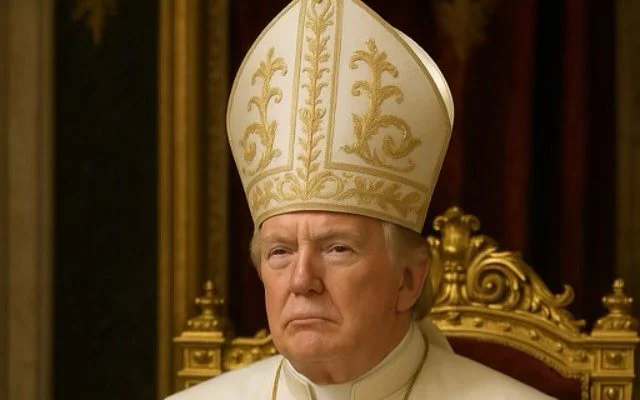In an unexpected turn of political theatre meets religious spectacle, President Donald Trump has once again stirred global headlines—this time by publishing an AI-generated image of himself dressed as the pope. The image, which quickly went viral after appearing on his Truth Social platform, shows the U.S. president in full papal regalia: white robes, a gold crucifix, and a towering mitre, with his right index finger pointed solemnly to the sky.
Coming just days before the Vatican’s conclave to elect the successor to the late Pope Francis, the post has reignited questions about Trump’s obsession with power and influence—both secular and spiritual. It also follows comments he made earlier this week that blurred the line between jest and ambition.
When asked during a press briefing who he hoped would succeed Pope Francis, Trump replied, “I’d like to be pope. That would be my number one choice.” Although he later added that he had no particular preference, he did single out “a cardinal out of New York” believed to be Timothy Dolan, the Archbishop of New York, calling him “very good.”
Trump’s AI papal image was uploaded without a caption but needed none. The symbolism and timing were clear—and polarizing.
Read More:
Confusion over age may disqualify African cardinal from Papal conclave
After Pope Francis’ death, focus turns to cardinals who will elect next pontiff
Pope Francis buried at Santa Maria Maggiore in Rome
Public and Political Reaction
While the post generated amusement among some of Trump’s supporters, critics were quick to denounce it as another instance of the president trivializing sacred traditions for personal spectacle.
Melanie D’Arrigo, a former Democratic congressional candidate, reacted sharply: “The guy who broke all Ten Commandments is posting pictures of himself cosplaying as the next pope.”
The Republicans Against Trump account went even further, declaring: “Trump just posted a photo of himself as the pope. It’s full-on lunacy at this point.”
Even within Republican circles, reactions ranged from cautious amusement to enthusiastic endorsement. Senator Lindsey Graham remarked last week, apparently in jest, that the conclave should “keep an open mind” about Trump as pope, adding that he was “excited” by the prospect.
Religious Context and Political Undercurrents
The mock papal post comes at a delicate time for the Vatican, as 133 eligible cardinals prepare to gather for the first conclave in two decades following a pope’s death. Pope Francis, who died on April 21, had often stood as a vocal critic of Trump’s policies, particularly on immigration and nationalism. In a 2016 comment that has since resurfaced, Francis told reporters, “Anyone, whoever he is, who only wants to build walls and not bridges is not a Christian.”
Trump’s visit to Pope Francis’s funeral last week marked his first official foreign trip since returning to power. His presence at the service, combined with the viral image, has been widely interpreted as part of a broader public relations strategy aimed at reshaping his image among Catholic voters—a group that made up 20 percent of the American electorate in the last election. Exit polls showed that nearly 60 percent of Catholic voters supported the Republican ticket.
Blurring Boundaries Between Faith and Power
While most observers view Trump’s papal ambitions as satirical, the broader implications raise serious questions about the fusion of politics, digital manipulation, and religious symbolism in modern leadership. In an age of AI-generated imagery and polarizing public figures, the boundaries between parody and propaganda have grown increasingly thin.
What remains clear is that President Trump’s unique brand of populism continues to dominate public discourse, even in places few expected it to reach—like the gates of the Vatican.
As the conclave prepares to convene on May 7, one thing is certain: while Trump will not be among the cardinals casting ballots under Michelangelo’s frescoes, his image—papal or otherwise—will remain etched in the spectacle surrounding one of the world’s most sacred traditions.

